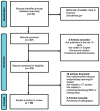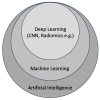Artificial Intelligence Applications for Osteoporosis Classification Using Computed Tomography
- PMID: 38135954
- PMCID: PMC10741220
- DOI: 10.3390/bioengineering10121364
Artificial Intelligence Applications for Osteoporosis Classification Using Computed Tomography
Abstract
Osteoporosis, marked by low bone mineral density (BMD) and a high fracture risk, is a major health issue. Recent progress in medical imaging, especially CT scans, offers new ways of diagnosing and assessing osteoporosis. This review examines the use of AI analysis of CT scans to stratify BMD and diagnose osteoporosis. By summarizing the relevant studies, we aimed to assess the effectiveness, constraints, and potential impact of AI-based osteoporosis classification (severity) via CT. A systematic search of electronic databases (PubMed, MEDLINE, Web of Science, ClinicalTrials.gov) was conducted according to the Preferred Reporting Items for Systematic Reviews and Meta-Analyses (PRISMA) guidelines. A total of 39 articles were retrieved from the databases, and the key findings were compiled and summarized, including the regions analyzed, the type of CT imaging, and their efficacy in predicting BMD compared with conventional DXA studies. Important considerations and limitations are also discussed. The overall reported accuracy, sensitivity, and specificity of AI in classifying osteoporosis using CT images ranged from 61.8% to 99.4%, 41.0% to 100.0%, and 31.0% to 100.0% respectively, with areas under the curve (AUCs) ranging from 0.582 to 0.994. While additional research is necessary to validate the clinical efficacy and reproducibility of these AI tools before incorporating them into routine clinical practice, these studies demonstrate the promising potential of using CT to opportunistically predict and classify osteoporosis without the need for DEXA.
Keywords: artificial intelligence; computed tomography; deep learning; imaging; machine learning; osteoporosis.
Conflict of interest statement
The authors declare no conflict of interest.
Figures



References
-
- Xiao P.L., Cui A.Y., Hsu C.J., Peng R., Jiang N., Xu X.H., Ma Y.G., Liu D., Lu H.D. Global, regional prevalence, and risk factors of osteoporosis according to the World Health Organization diagnostic criteria: A systematic review and meta-analysis. Osteoporos. Int. 2022;33:2137–2153. doi: 10.1007/s00198-022-06454-3. - DOI - PubMed
Publication types
Grants and funding
LinkOut - more resources
Full Text Sources

